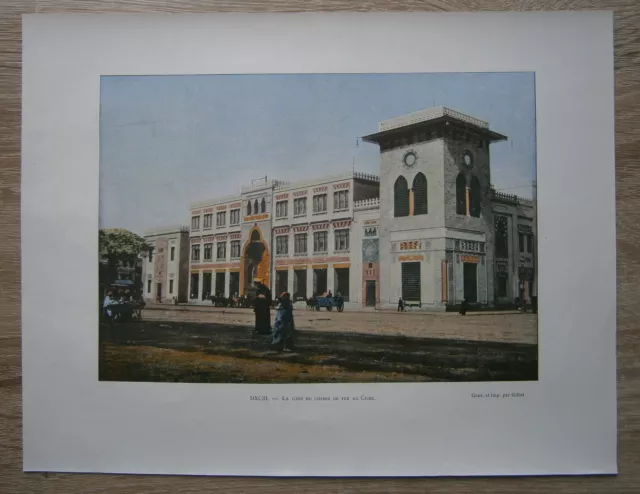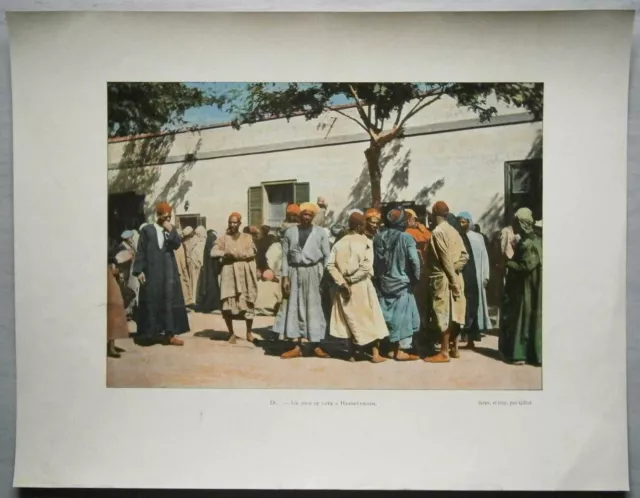ca.1895 French photochrom STATUES OF RAMSES AT ABU SIMBEL, EGYPT (#471)
| ca.1895 French photochrom STATUES OF RAMSES AT ABU SIMBEL, EGYPT (#471) |
Photochrom titled Ibsamboul, Statues de Rhamses, page size 31 x 24 cm, image size 22 x 15.5 cm. From: Autour du Monde - Aquarelles - Souvenirs de Voyages, Paris, L. Boulanger, editeur.
Click image or here to view larger version
Abu Simbel also spelled Abu Sunbul, site of two temples built by the Egyptian king Ramses II (reigned 1279–13 BC), now located in Aswan muhafazah (governorate), southern Egypt. In ancient times the area was at the southern frontier of pharaonic Egypt, facing Nubia. The four colossal statues of Ramses in front of the main temple are spectacular examples of ancient Egyptian art. By means of a complex engineering feat in the 1960s, the temples were salvaged from the rising waters of the Nile River caused by erection of the Aswan High Dam. Carved out of a sandstone cliff on the west bank of the Nile, south of Korosko (modern Kurusku), the temples were unknown to the outside world until their rediscovery in 1813 by the Swiss researcher Johann Ludwig Burckhardt. They were first explored in 1817 by the early Egyptologist Giovanni Battista Belzoni. The 66-foot (20-metre) seated figures of Ramses are set against the recessed face of the cliff, two on either side of the entrance to the main temple. Carved around their feet are small figures representing Ramses' children, his queen, Nefertari, and his mother, Muttuy (Mut-tuy, or Queen Ti). Graffiti inscribed on the southern pair by Greek mercenaries serving Egypt in the 6th century BC have provided important evidence of the early history of the Greek alphabet. The temple itself, dedicated to the sun gods Amon-Re and Re-Horakhte, consists of three consecutive halls extending 185 feet (56 metres) into the cliff, decorated with more figures of the king and with painted reliefs showing his life and achievements. It was built so that, on two days of the year (about February 22 and October 22), the first rays of the morning sun would penetrate its whole length and even illuminate the shrine in its innermost sanctuary. Just to the north of the main temple is a smaller one, dedicated to Nefertari for the worship of the goddess Hathor and adorned with 35-foot (10.5-metre) statues of the king and queen. In the mid-20th century, when the reservoir that was created by the construction of the nearby Aswan High Dam threatened to submerge Abu Simbel, the United Nations Educational, Scientific and Cultural Organization (UNESCO) and the Egyptian government sponsored a project to save the site. An informational and fund-raising campaign was initiated by UNESCO in 1959. Between 1963 and 1968, a workforce and an international team of engineers and scientists, supported by funds from more than 50 countries, dug away the top of the cliff and completely disassembled both temples, reconstructing them on high ground more than 200 feet (60 metres) above their previous site. In all, some 16,000 blocks were moved. In 1979 Abu Simbel, Philae, and other nearby monuments were collectively designated a UNESCO World Heritage site.
Photochrom
Photochrom (also called the Aäc process) prints are colorized images produced from black-and-white photographic negatives via the direct photographic transfer of a negative onto lithographic printing plates. The process is properly considered a photographic variant of chromolithography, a broader term referring to color lithography in general.
History
The process was invented in the 1880s by Hans Jakob Schmid (1856–1924), an employee of the Swiss company Orell Gessner Füssli, a printing firm with a history extending back into the 16th century. Füssli founded the stock company Photochrom Zürich (later Photoglob Zürich AG) as the business vehicle for the commercial exploitation of the process and both Füssli and Photoglob continue to exist today. From the mid 1890s on the process was licensed by other companies including the Detroit Photographic Company in the US and the Photochrom Company of London.
The photochrom process was most popular in the 1890s, when true color photography was first being developed but was still commercially impractical.
In 1898 the US Congress passed the Private Mailing Card Act which allowed private publishers to produce postcards. These could be mailed for one cent each — the letter rate at the time was two cents. Thousands of photochrom prints, usually of cities or landscapes, were created and sold as postcards and it is in this format that photochrom reproductions became most popular. The Detroit Photographic Company reportedly produced as many as seven million photochrom prints in some years, and ten to thirty thousand different views were offered.
After World War One, which brought an end to the craze for collecting Photochrom postcards, the chief use of the process was printing posters and art reproductions, and the last Photochrom printer operated up to 1970.
Process
A tablet of lithographic limestone, known as a "litho stone," is coated with a light-sensitive coating, comprising a thin layer of purified bitumen dissolved in benzene. A reversed half-tone negative is then pressed against the coating and exposed to daylight for a period of 10 to 30 minutes in summer, up to several hours in winter. The image on the negative allows varying amounts of light to fall on different areas of the coating, causing the bitumen to harden and become resistant to normal solvents in proportion to the amount of light that falls on it. The coating is then washed in turpentine solutions to remove the unhardened bitumen and retouched in the tonal scale of the chosen color to strengthen or soften the tones as required. Each tint is applied using a separate stone bearing the appropriate retouched image. The finished print is produced using at least six, but more commonly from 10 to 15, tint stones.
Please e-mail me if you have any questions. I prefer payment by PayPal, but I'll also accept any other payment method and currency (except direct payment by credit card) that is convenient for buyer. I combine shipping of multiple items.
IMPORTANT NOTE ABOUT SHIPPING: Price quoted with auction is for airmail to the US. Please don't pay before you receive invoice from me.
- Original/Reproduction: Original Print
- Listed By: Dealer or Reseller
- Print Type: Engraving
- Subject: Architecture & Cityscape
- Style: Realism
- Size Type/Largest Dimension: Small (Up to 14")
- Date of Creation: 1800-1899
PicClick Insights - ca.1895 French photochrom STATUES OF RAMSES AT ABU SIMBEL, EGYPT (#471) PicClick Exclusive
- Popularity - 1 watcher, 0.0 new watchers per day, 278 days for sale on eBay. Normal amount watching. 0 sold, 1 available.
- Best Price -
- Seller - 5,402+ items sold. 0% negative feedback. Great seller with very good positive feedback and over 50 ratings.
People Also Loved PicClick Exclusive

ca.1895 French photochrom STATUES OF RAMSES AT ABU SIMBEL, EGYPT (#471)
$25.00 Buy It Now or Best Offer
ca.1895 French photochrom MINGRELIAN WOMAN AT SPRING, GEORGIA, CAUCASUS (#332)
$19.96 Buy It Now or Best Offer
ca.1895 French photochrom ON BANKS OF NILE AT BEDRECHEIN, NEAR CAIRO, EGYPT
$19.99 Buy It Now or Best Offer
ca.1895 French photochrom RAILWAY STATION IN CAIRO (RAMSES STATION), EGYPT (#593
$29.00 Buy It Now or Best Offer
ca.1895 French photochrom PAYDAY AT HANONVADIEH, EGYPT, #600
$24.99 Buy It Now or Best Offer